Varicose veins (varicose veins) - a condition in which the veins increase in diameter, become enveloping. Very often this is due to the compromise of the venous valves.
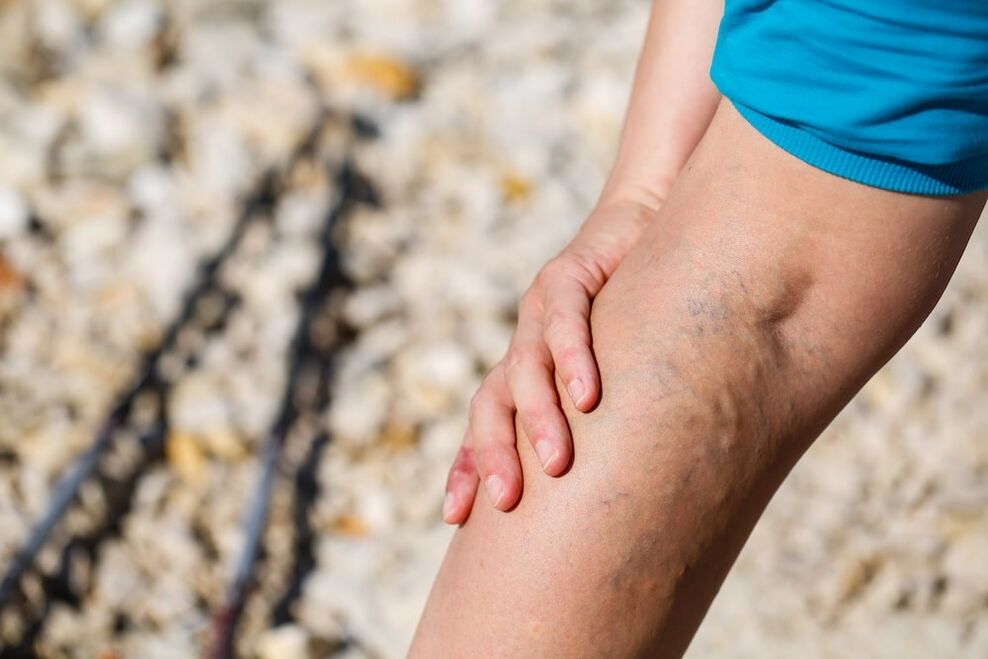
Venous system. Characteristics of the structure of the veins.
The venous vessels are part of the cardiovascular system, bring blood with peripheral heart tissues. The opinion that venous blood always flows through the veins and arteries always flows into the veins. In reality, this is not always the case. For example, the lung arteries transport venous blood from the heart to the lungs and the lung veins are returned from the lungs to the heart of the artery.
In many arteries, the blood flows at high pressure, so they have a dense thick wall. On the contrary, in the veins the blood pressure is quite low, so their wall is thinner and less dense. In the lumen of many veins there are valves: they pass blood in one direction, thus contributing to its progress towards the heart. The valves are absent only in the veins of the head and neck, since they are above the heart, the blood flows freely.
What happens in the veins? The essence of varicose veins.
The walls of the veins of the lower ends are forced to constantly experience an increase in loads, since the flow of blood through these vases occurs against gravity. The main mechanisms that lead to varicose veins:
- excessive lengthening of the venous wall;
- Interruption of venous valves.
It is far from possible to say exactly because these pathological changes occur in the veins. There are factors that increase the risk of varicose veins.
The causes of varicose veins
Factors that increase the risk of the disease:
- Direction. This factor is present in all people. The legs are the most remote from the heart of the body, which is under the rest during the feet and walking. Venous blood is very difficult to go back to the heart from the feet.
- Age. As the risk of varicose veins increase, with the advance of venous valves. They stop closing completely, so that a small amount of blood can flow in the opposite direction. It is stagnated in the veins of the legs, instead of returning to heart.
- Flooring. Women suffer from varicose veins more often than men. This is facilitated by hormonal changes in the female body during pregnancy, in postmenopause, before menstruation. Female sex hormones contribute to the relaxation of the walls of the veins.
- Hormone replacement therapy and taking oral contraceptives.
- Inheritance. More members of your family suffer from varicose veins of the lower ends, the greater the risks.
- Obesity. The extra kilos contribute to increasing the load on the cardiovascular system. The pressure in the veins increases.
- Standing or sitting for a long time. This leads to the stagnation of the blood in the veins of the lower body. For example, employees, surgeons and other people who "are standing" and "seats" often suffer from varicose veins.
- Pregnancy. During pregnancy, women suffer from varicose veins much more often than in other periods of life. This is due to some physiological changes in the body of a pregnant woman.
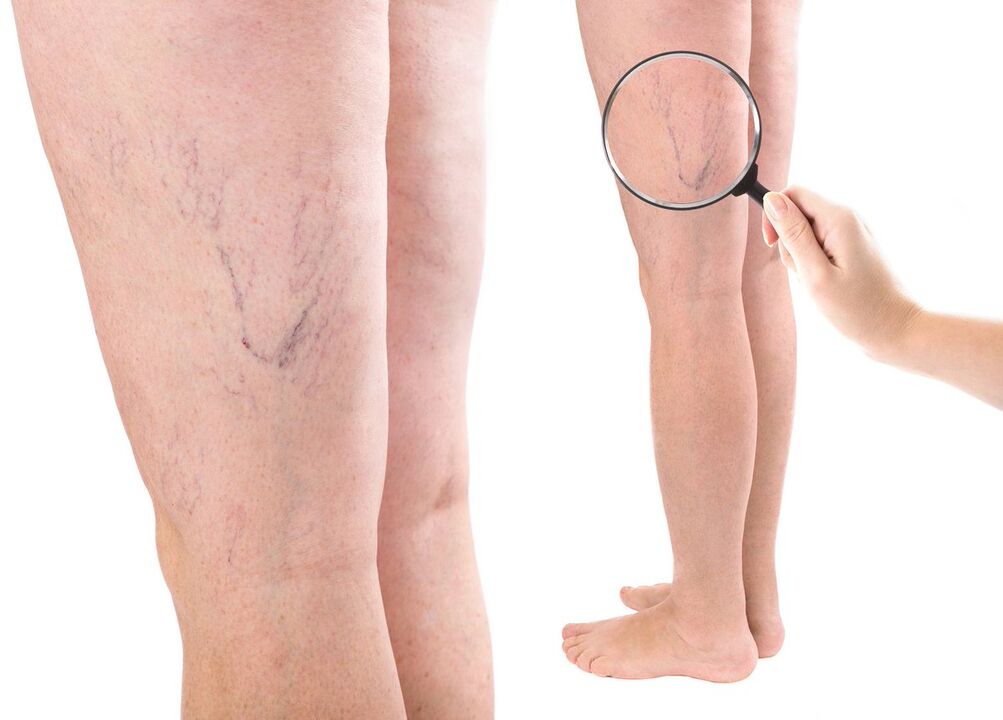
Signs of varicose veins
- Evident expansion of subcutaneous veins. They increase, become tortuous, clearly visible under the skin. The veins in a several dilated way seem to be cereals, the "worms" of blue or dark purple. This image occurs only with varicose veins located under the skin. If venous ships located deeper in the fabrics are affected, it is impossible to note this externally.
- Feeling of gravity in the legs. It usually occurs or intensifies after intense physical effort, in the evening and at night.
- Various unpleasant sensations. It can be a burning feeling, a feeling of pulsation, tingling, numbness.
- Swelling on the legs. The stagnation of the blood in the varicose veins leads to the fact that the fluid begins to dwell and accumulate in the tissues. The edema takes place closer in the evening, as a rule, first only on the feet. As a violation of the outflow of venous blood increases, the swelling extends to the lower legs, to the hips.
- Muscle cramps. They present themselves due to a violation of the flow of blood to the tissues, when a person represents for a long time.
- Leg pain. Not all patients are worried. Intensify with a prolonged position.
Complications of varicose veins
In most patients, varicose veins do not lead to complications. But the following states can occur:
- Bleeding. In case of damage to the skin in the varicose veins area, bleeding occurs, which may not stop for a long time. In such cases, you have to lie down, lift your legs and press the bleeding area. If the blood continues to go, you need to consult a doctor.
- Ulcers for varicose veins. Very painful, more often located in the ankle. The ulcers occur due to edema and blood supply compromised to the tissues in the varicose veins area. Usually an ulcer is preceded by a pale point on the skin. If this complication is presented, it is necessary to immediately consult a doctor.
- Thrombophlebitis for varicose veins. A condition in which blood clots occur on the venous wall and inflammation occurs. In the area of damage, a feeling of heat, redness, pain may occur. Usually, with this complication, the doctor prescribes compression linen, painkillers.
- Chronic venous deficiency. A condition in which the exchange of oxygen, nutrients and waste products between the skin and blood is disturbed, due to the compromised blood intake. Chronic venous deficiency increases the risk of pathologies such as eczema, tough dense skin, trophic ulcers.
- Venous eczema (stagnant dermatitis). Skin injury caused by the stagnation of venous blood and the formation of edema. The main symptoms: red spots, peeling, itching in the field of varicose veins.
- Restless leg syndrome. It is characterized by unpleasant sensations in the legs that arise at rest. The patient must constantly make movements, which is why sleep is often disturbed.
Compression linence for varicose veins
The compression socks and the elastic bandages with varicose veins compress the dilated veins, thus improving blood circulation. As a rule, the compression underwear envelops the legs around the closest ankles and it gradually becomes more free. It helps blood move through the veins in the direction of the reverse force of gravity - up to the heart.
Many patients note that compression stockings and elastic bandages help to cope with discomfort, pain, edema.
Despite the fact that the compression linen helps to improve blood flow and to face some symptoms, it does not heal varicose veins. During the studies, ambiguous results have been obtained, therefore scientists cannot say whether compression stockings help to eliminate or prevent varicose veins.
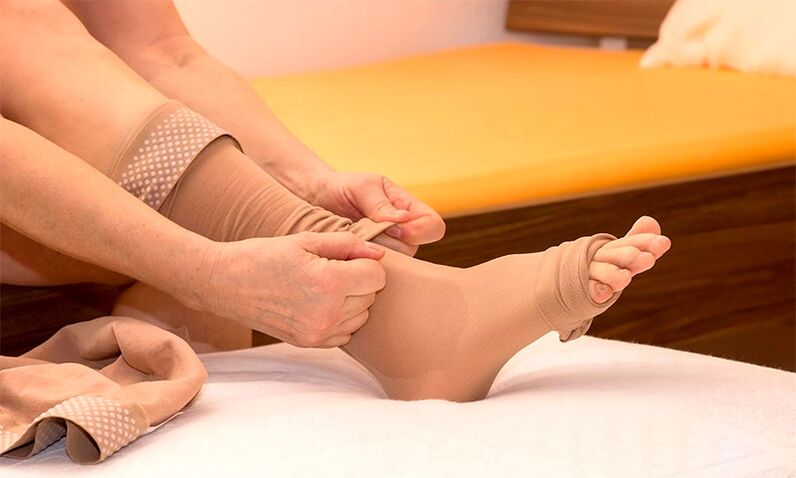
Compression linen variety:
- Socks and tights. The most common type of compression laundry. The socks reach the hips, the tights - up to life. Compression tights are more convenient, as they are firmly fixed and do not slip.
- Golfs. They reach the knee. Often used by men. There are several models.
- Elastic bandages. There are different lengths, they can only be intended for the banding of the lower part of the leg or the lower part of the leg and hips. This is the cheapest variety, but more uncomfortable than compression linen. The bandage must be applied longer than tights or socks, it flows constantly. The degree of compression is controlled manually by regulating the force of the bandage and is not always adequate.
Operations for varicose veins
With varicose veins pronounced on the legs, they resort to surgical treatment. Usually the operation is performed under general anesthesia. In most cases, the patient is discharged from the hospital on the day of surgery. If the operation is performed on two legs, maybe it will be necessary to spend a night in the hospital.
There are different types of surgical treatment of varicose veins.
Dress and removal of an expanded vein
Two cuts are made: one in the groin, the other below, in the ankle, in the knee or in another place. In the upper section it is located, blindfolded and crossed by a vein. Through it, a special thin wire is performed in the lower section, after which it is pulled together with what is below. The removal of the surface vein will not affect the flow of blood to the leg, since its functions will take the deep veins.
Possible complications of the dressing and removal of the vein:
- the formation of great bleeding;
- bleeding;
- Pain;
- A very rare complication is the deep vein thrombosis.
The restoration of performance after this operation in most patients takes place within 1-3 weeks. All this time you will have to wear compression socks. If there is venous insufficiency, compression underwear must be used in the long term.
Sclerotherapy
During this procedure, a special substance is introduced into the vein, which damages its wall from the inside and leads to the overlap of the light. Varicosis takes place within a few weeks. Sometimes medicine must be administered several times.
Radiff ablation
The technique involves heating the wall vein using radio frequency energy. The course of the procedure:
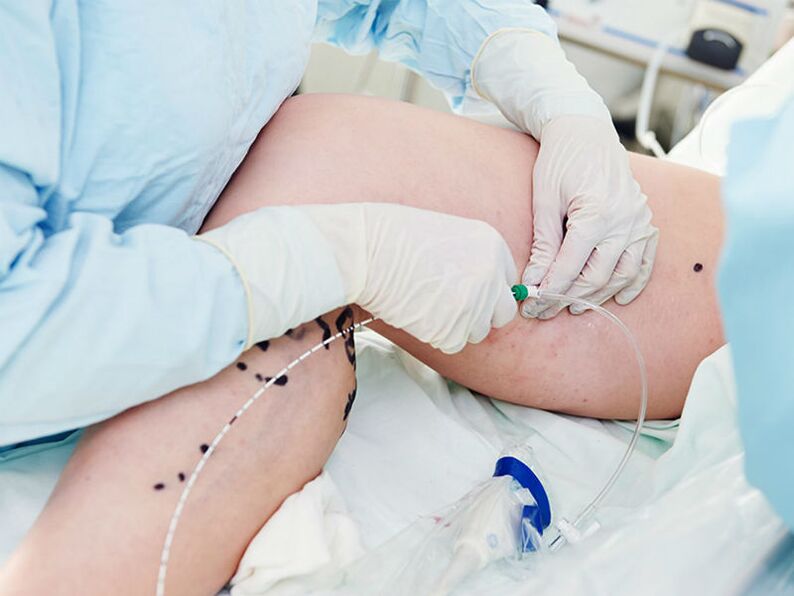
- A small cut is carried out above or under the knee and access to Vienna.
- Under the control of the ultrasound, a catheter (a half flexible tube) is performed in a vein.
- So, through the catheter, the doctor leads a probe that emits energy on radio frequency.
- The energy emitted by the probe warms the wall sells from the inside, causes the burns and closure of the ship of the ship.
Usually this operation is performed under local anesthesia, without anesthesia. During the procedure, the patient can experiment with small unpleasant sensations that resemble injections with pins. Sometimes a small burning of the skin occurs. Within a few weeks of radio frequency ablation, compression linen must be worn.
Treatment of varicose veins with a laser
The closure of the vein lumen can also be caused by the irradiation of its wall from the inside with a laser. The course of the procedure:
- A catheter is introduced into the patient vein.
- A source of laser radiation is carried out through a catheter in Vienna.
- The laser causes the heating of the vein, the burns of its walls from the inside and the ceiling of the light.
- The surgeon directs the laser rays under the control of ultrasound and gradually burns the wall vein.
As a rule, the treatment of varicose veins with a laser is carried out under local anesthesia. The procedure is effective in 98% of cases.
Exercises for varicose veins
Therapeutic gymnastics can be useful for varicose veins. Below we will consider the simplest series of exercises, but before their implementation you absolutely must consult a doctor. Only the doctor will be able to say exactly what loads are not contraindicated and are able to benefit.
How gymnastics can help with varicose veins:
- improve the outflow of venous and lymphatic vessels;
- Improvement of the flow of blood to the lower limbs;
- increasing the tone of the walls of the veins;
- improvement of blood circulation in small pots;
- Strengthen the leg muscles, increasing their resistance.
Massage for varicose veins
The massage can be used for varicose veins, but not always, it depends on the degree of gravity and the presence of complications. Do not engage in the car -massage, it is better to contact a professional masseur.
The massage for varicose veins helps to reduce symptoms such as swelling, convulsions, numbness and other discomfort. It relieves tension in the muscles and helps to restore the normal tone of the venous walls. With varicose veins, the massage is often combined with physiotherapy exercises.
How to manage varicose veins at home?
There are some measures that can be used independently, at home to slow down the progression of varicose veins and reduce the sense of discomfort to which it is accompanied by:
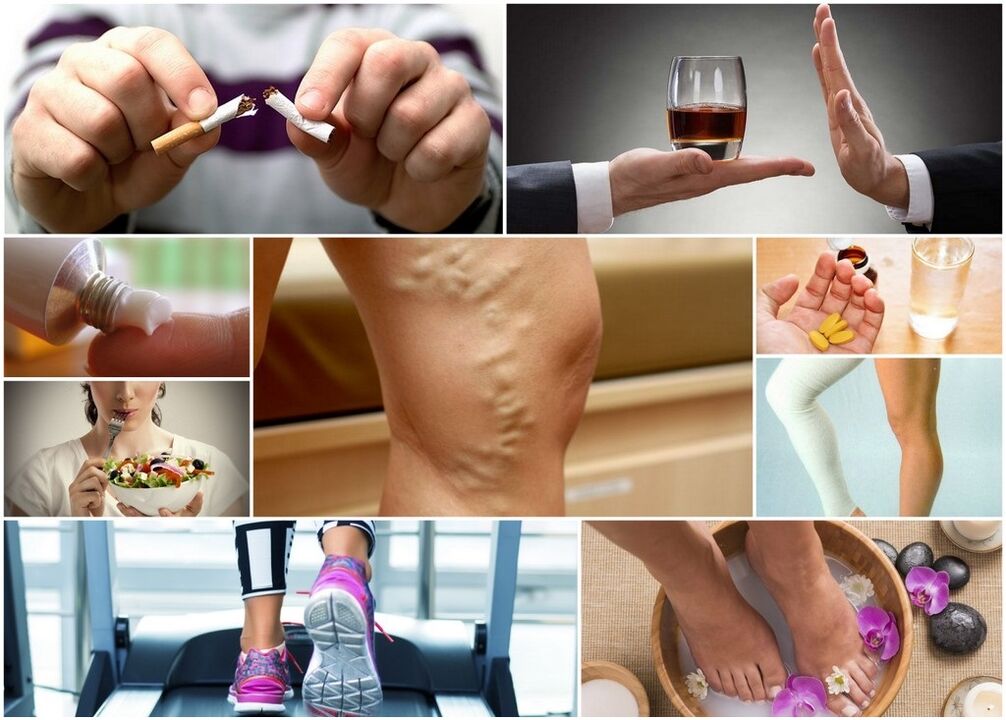
- Physical activity. Walking helps to strengthen the leg muscles and improve the outflow of venous blood. Consult your doctor, he will advise the level of physical activity suitable for you.
- Maintain a healthy weight. Adhere to a healthy diet. If you suffer from excess body weight or obesity, try to get rid of extra kilos. Consult a nutritionist: a specialist will provide recommendations on the nature of food that will be optimal in your case.
- The right choice of clothes. Do not wear high wheel shoes, tight linen and clothes that tighten the veins.
- Raising the legs. It will be very good if you can periodically take breaks and lift your legs over the level of the heart. When you sleep or lie on the bed, put 3-4 cushions under your feet.
- It breaks with session or prolonged standing. Try to move every 30 minutes.
- Don't put your foot on your leg when you sit. For this reason, the veins are squeezed, the flow of blood is even more disturbed.
Prevention of varicose veins
It is impossible to completely prevent varicose veins. Existing preventive measures only help to delay the disease or slow down its progression if it has already arisen.
- If you have to sit or stand for a long time, make sure you take breaks. Walk, go away. If possible, you can lie down and lift your legs.
- Try to keep your legs in a raised position when you are sitting, rest, sleep. Sometimes it is useful to go to the sofa or floor and keep your legs raised, placing them against the wall.
- More often your legs are higher than the heart level, better for their veins.
- Perform physical exercises that help to strengthen the leg muscles. Thanks to this, the movement of the blood will improve through the veins.
- If you have overweight or obesity, try losing weight. This will not only reduce the risks of varicose veins, but will also positively influence the conditions of the entire cardiovascular system.
- Do not wear narrow clothes, in particular one that pulls alive, groin, legs. For this reason, the flow of blood through the veins can worsen.
- Try to wear high -wheeled shoes as little as possible. For this reason, the tone of the legs of the legs is disturbed, they stop helping to push the blood through the veins.


















